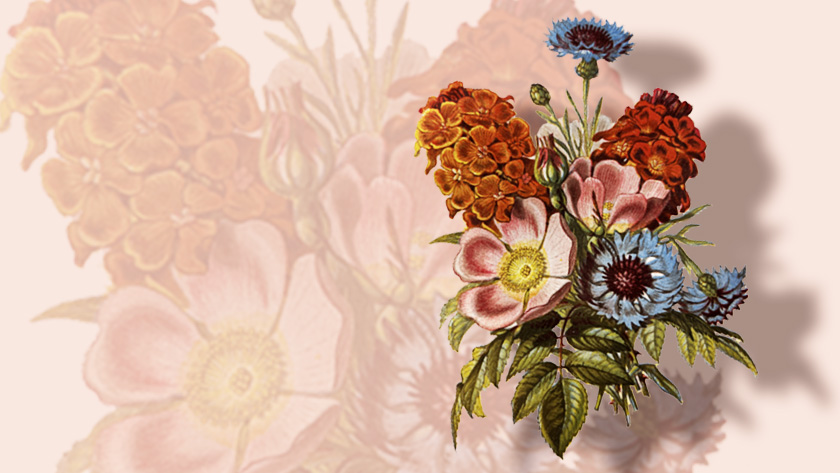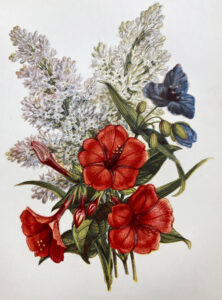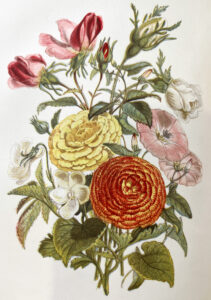
From The Language of Flowers: Or, Floral Emblems of Thoughts, Feelings, and Sentiments by Robert Tyas, 1875.
How to Speak the Language of the Flowers: Floral Dictionaries in the Horticulture Collection
Article by Ellen Dubs, 2022 Summer Fellow with the Special Collections Department in UD’s Undergraduate Research Program
They say a picture is worth a thousand words, but how about a bouquet of flowers?
Over 2,000 years ago, ancient civilizations regarded flowers as sacred symbols. The importance of flowers continued to evolve, with people across the world cultivating, arranging and painting blooms. By the 16th century, flowers permeated all art mediums, from the wood etchings and silk scrolls of Ancient China to vibrant paintings of the Renaissance.

From The Language of Flowers: Or, Floral Emblems of Thoughts, Feelings, and Sentiments by Robert Tyas, 1875.
The popularity of horticulture grew to new heights in the 19th century with a secret code of floral symbology derived from religion and mythology known as the “Language of Flowers.” Victorians used “floriography” to escape the rigid decorum of letters or spoken word through the exchange of flowers and bouquets.
Floral dictionaries were key to understanding this code. They listed the various meanings of flowers and how to arrange bouquets alongside vibrant illustrations and verse. You’ll find hundreds of these unique dictionaries within the Unidel Collection of the History of Horticulture and Landscape Architecture in Special Collections.
Below, discover how to send, receive and display messages just like the Victorians, using an assortment of blooming flowers in our own backyards.
1. Select Your Dictionary
The first step to assembling a “talking bouquet” is selecting a floral dictionary. While some flowers, like the rose, have universal symbolism, other blooms carry different meanings depending on the culture, time and region. Some guides derive their meaning from Greco-Roman mythology, Eastern influence or classic literature while others draw on the author’s sensory observations of the plant. The country a floral dictionary was written in also influences the meaning. For example, the pansy represents thought as its name comes from the French word “penser,” which means to think.
2. Select Your Flowers
The most important and complex step is selecting flowers and greenery. While we may think of flowers conveying a romantic message, “talking bouquets” could also communicate fondness and well wishes to friends or displeasure and resentment. Victorians carefully considered the color, age, size and placement of flowers since small variations could completely change the meaning. They also accentuated their bouquets with herbs, berries and leaves, each also containing a distinct meaning. Check out the quick guide below for a crash course on flower meanings.
3. Arrange Your Flowers

From The Language of Flowers: Or, Floral Emblems of Thoughts, Feelings, and Sentiments by Robert Tyas, 1875.
Imaginative Victorians arranged and tied their bouquets to convey several different meanings. The traditional “talking bouquet” was a set of tied flowers. The Tussie-Mussie was a delicate, fragrant bouquet wrapped in lace doilies with herbs in the center, which was often given to a lover. Nose-gays were especially fragrant arrangements carried or pinned to the chest to block out less pleasant aromas.
4. Give Your Flowers to Someone
In floriography, flowers that are passed with the right hand indicate “yes,” while those passed with the left indicate “no.” Tilting bouquets also change the meaning, with a left movement the passer refers to themselves while the right direction indicates the recipient.
5. Receive Flowers from Someone
The recipient can also indicate their intentions through how they handle flowers. If you want to turn down an eager suitor, you can point the bouquet downward or pin it a few inches away from the heart. To accept a declaration of love, the recipient could pin the bouquet to their heart or bring it to their lips.
6. Display Your Flowers
Victorians also had several options for displaying their arrangements, including a funnel-shaped posy holder, which allowed them to attach their bouquet via a delicate chain. Ornate posy holders allowed women to pin arrangements to their dresses while protecting them from water droplets. The closer a posy-holder was moved to the heart, the better the chance a suitor had.
Quick Guide to Flower Meanings
Red Rose – Deep Love
Hydrangea – Constant Love
Periwinkle – Fond Memories
Daisy – Happiness, Friendship
Pale Yarrow – Everlasting Love
White Jasmine – Beauty, Sensual Love
Violet – Modesty
Peach Blossom (Delaware’s State Flower) – Charm and Generosity
Zinnia – Lasting Affection, Remembrance of Absent Friends
Iris – Eloquence, Communication
Lavender – Distrust
Petunia – Anger, Deep Resentment
Yellow Rose – Decreasing Love
Sunflower – Fake Love
Yellow Tansy – Declaration of War
Hundreds of floral dictionaries are available in the Unidel Collection of the History of Horticulture and Landscape. Within the collection, you will find more than 1,000 books, catalogs, periodicals, journals and illustrations from across Europe and America that speak to the art and impact of cultivating plants in gardens.
Through the collection, you can learn about the cultivation of functional and medicinal plants. Explore how horticulture impacted cultural trends of the 18th and 19th centuries, including Westward expansion and the changing roles of women and children. Discover how the rise of gardening reflects a movement toward leisure and sentimentality. Gain insight into the growth of the seed and nursery trades through advertisements and distribution, and much more.
If you are interested in seeing any of the materials from the collection, please contact Special Collections at AskSpec.
